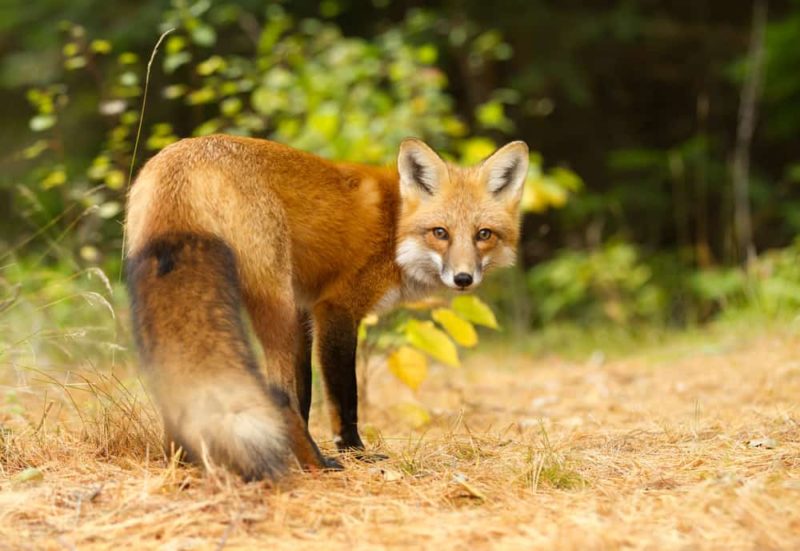The Fox is the smallest of the wild dogs of North America and one of the most intelligent of all wild animals. If you are interested in foxes, I’ve researched the six subspecies that live in North America. I will go into where they live and what characteristics they have.
The most noteworthy feature of the fox is its bushy tail. The tail is 1/3 of its body’s length. The fox will curl up tightly in the cold weather with its tail to cover its face, paws, and legs.
The fox has oval eyes, which are different than the round eyes of the dog family. Their whiskers are longer than their dog cousins; they almost resemble cat whiskers.
They have well-developed hearing and can easily hear a mouse rustling in the grass or under 2 ft. of snow. They are capable of vaulting around 15 feet.
How Many Species of Fox are There in North America?
There are twelve species of fox in the world, 6 of them being in North America. Many of their characteristics are the same, but they each have their differences.
| Red fox (Vulpes Fulva) | – Largest of the foxes. – White-tip on his tail. – Vertical pupils that can narrow to a slit, thus reducing the amount of bright sunlight. – Black feet and black-tipped ears. – Red fur on the face, back, sides, and tail. – Chin, throat, and belly are grayish-white. – Stands 15″ at the shoulder. – Averages 8 – 14 lbs. |
| Gray fox (Urocuon Ceneroargenteus) | – A bit smaller than the Red fox. – Black-tip on his tail. – Salt and peppery colored coat. – Red and white fur around their face. – Stands 15″ at the shoulder. – Averages 7 – 11 lbs. |
| Kit fox (Vulpes Velox) | –Black-tip on his tail. – Yellowish gray coat with a lighter underbelly. – Stands 12″ at the shoulder. – Averages 4 – 6 lbs. |
| Island fox (Urocyon littoralis) | – Smallest of the Foxes. – Gray fur on its head, a copperish orange coloring on its sides. – White fur on the lower half of its face, throat, and belly. – Black stripe on the dorsal surface of its tail. – Stands 6″ at the shoulder. – Averages 2 – 6 lbs. |
| Swift fox (Vulpes velox) | – Dark grayish tan fur on the body. – Yellow tan on legs & sides. – Black patches on the muzzle. – Black-tip on its tail. – Stands 12″ at the shoulder. – Averages 5 – 7 lbs. |
| Arctic fox (Alopex Lagopus) | – Shorter nose. – Short round ears. – White fur in Winter and brown in the summer. – Stands 12″ at the shoulder. – Heaviest at 15 lbs. |
Red Fox
“The red fox is the largest of the true foxes and one of the most widely distributed members of the order Carnivora, being present across the entire Northern Hemisphere including most of North America, Europe, and Asia, plus parts of North Africa” Wikipedia.
Where Do Red Foxes Live?
Red Foxes are native to North America and can be found in both the United States and Canada.
There are 9 Subspecies of the North American Red Fox:
- British Columbian fox– found in British Columbia and South-Eastern Alaska
- Northern Alaskan fox– found in Alaska
- Cascade Mountains red fox– found in Washington
- Eastern American red fox – found in the Eastern United States and Canada
- Wasatch Mountains fox- found in Utah, Colorado, Idaho, Wyoming, Montana, and Southern Alberta Canada
- Sierra Nevada red fox or High Sierra fox– found in the High Sierra’s of California
- Sacramento Valley red fox– found in Sacramento Valley California
- Northern plains fox– found in Minnesota
- Nova Scotia fox – found in Nova Scotia Canada
What Do Red Foxes Look Like?
Red foxes have long noses and red fur on the face, back, sides, and tail. Their chin, throat, and belly are grayish-white. They have black feet and black-tipped ears that are large and pointy. They are around two feet tall and three feet long. One of the most defining characteristics of the red fox is its fluffy white-tipped tail. Red foxes are often confused with the grey fox because some red foxes have large patches of gray fur and some gray foxes have patches of red fur. They also share similar habitats and ranges.
A guaranteed way to tell the difference is to look for the color at the tip of their tail. Red foxes have white-tipped tails, while Gray foxtails are black.
Foxes have oval-shaped eyes. The Red fox has vertical pupils that can narrow to a slit to reduce bright sunlight. They also have great night vision.
What Do Red Foxes Eat?
Foxes are omnivorous predators. Their diet mainly consists of small mammals, especially rodents like rats, mice, voles, and squirrels. They will also eat rabbits and hares. They will also supplement their diet with insects and worms.
A good proportion of a growing fox cub’s diet consists of insects and worms, seeing as they can catch them in the earth’s surroundings.
Do Red Foxes Attack Pheasants?
The answer to this question is yes. Pheasants are one of the critters that the red fox love to pray on. In fact, it is said that if there are plenty of coyotes around them, Pheasants are abundant because the coyote will prey on its smaller brother, the fox.
The following is an article written in The Courier.co.uk “Almost 100 birds killed in ‘frenzied’ fox attack at Angus farm.”
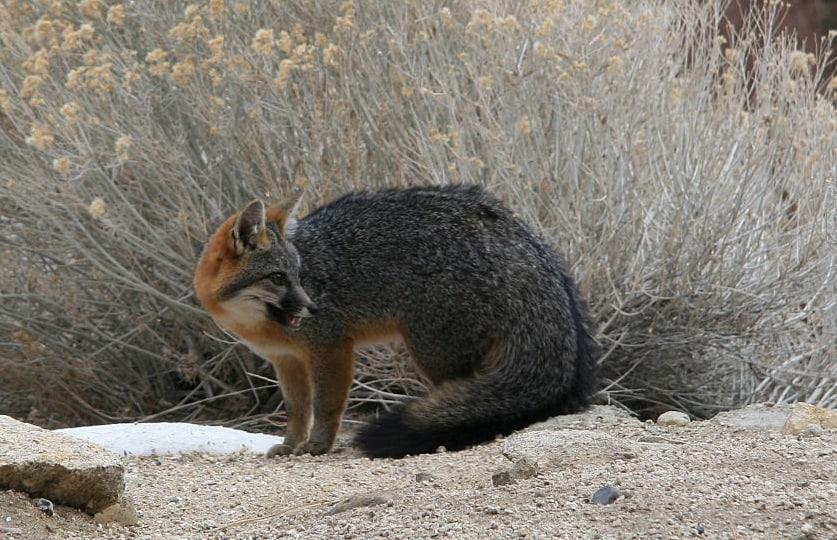
Gray Fox
Fun fact: They are the only fox that climbs trees.
Where Do Gray Foxes Live?
The Gray fox lives throughout most of the rocky, brushy regions from southern Canada through the United States (except the northwestern mountains) through Mexico to the north of South America as far south as Venezuela. It is the only wild dog whose natural range spans both North and South America.
What Do Gray Foxes Look Like?
They have salt and peppery colored coats on their bodies with patches of red and white fur around their faces. The Grey Fox looks similar to the Red Fox, making it sometimes difficult to tell them apart. The one telling feature of the Grey Fox is that they have a black tip on their tails’ end. They are a bit smaller than most Red Foxes weighing in at around 7-11 lbs.
What Habitat Do Gray Foxes Live In?
The Gray fox prefers rocky canyons and ridges, but can also be found in grasslands, woody areas, and hot, desert areas. Their den sites can often be found by following worn trails. The Gray Fox will use a ground den, but he prefers a hollowed-out log or hollow tree. They do not keep a tidy den, and you will find bones of their prey near their den site.
What Do Gray Foxes Eat?
Gray foxes are omnivores. They eat a wide variety of nuts, berries, insects, birds, fruit, small mammals, eggs, and lizards. They are even known to raid people’s trash cans looking for something to eat.
What is the Fastest Fox in the World?
This is a good question. You would think that the Swift fox would be the fastest since it is named the Swift Fox. They have been clocked in at speeds of over 50 km/h (30 mph) or up to 60 km/h (40 mph). In reality, the Gray Fox is the fastest, with speeds clocked in at 67.59 km/m (42 mph).
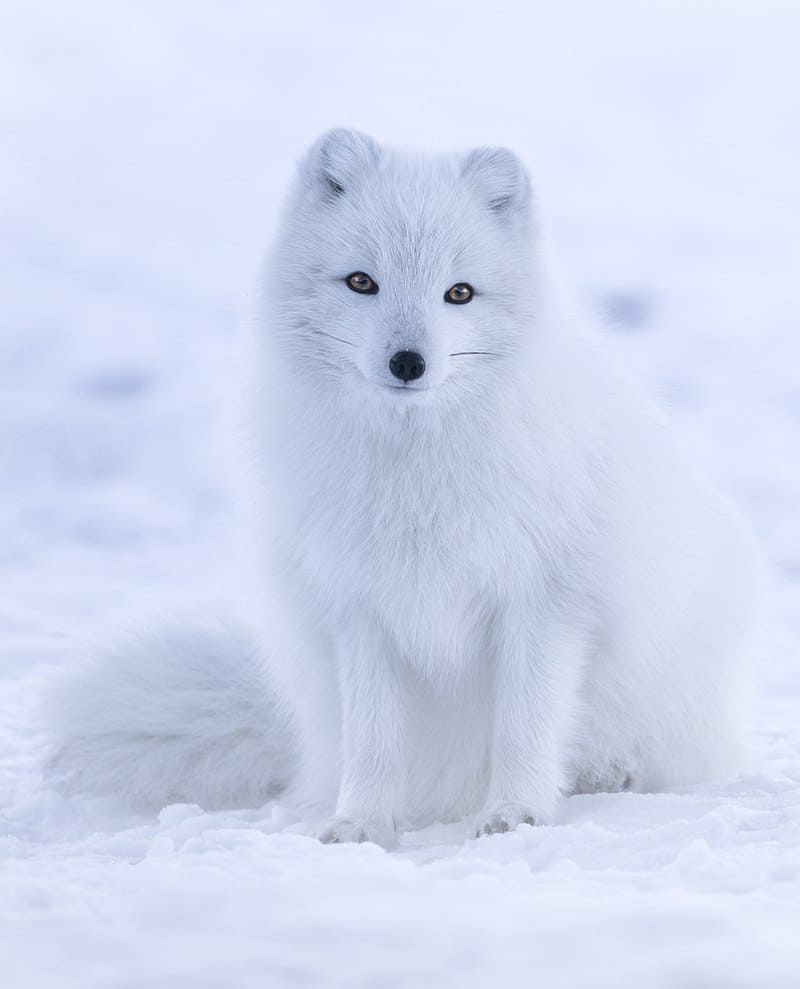
Arctic Fox
Where do Arctic Foxes Live?
Arctic Foxes live in the harsh arctic climates of North America and Canada.
What Do Arctic Foxes Eat?
The Arctic fox preys on many small creatures such as lemmings, voles, ringed seal pups, fish, waterfowl, ptarmigan, and seabirds. It also eats carrion, berries, seaweed, and insects. The Arctic Fox is the friendliest of the foxes. They will follow trappers and hunters around, hoping for an easy meal. They also will eat the leftovers from a larger animal’s kill or a beached whale.
What Do Arctic Foxes Need to Survive?
An Arctic Fox needs to survive in temperatures as low as -58 degrees F (-50 degrees C). Their compact bodies help to minimize the surface area that is exposed to cold air. They also have a thick layer of fur that traps air and preserves their body heat. Their thick fluffy tails also help keep them warm as they curl up to sleep, adding insulation.
They are the only member of the canid family that grows fur over their footpads, protecting them as they walk over the snow and ice. They also have counter-current blood circulation, which reduces blood flow to their feet to ensure they don’t get frostbitten. When conditions become too cold, their metabolism increases to provide warmth. Not only does this help them to withstand frigid temperatures, but it also enables them to survive longer without food.
Their fur also changes color according to the season. When it is cold and snowy, they are white, and when the snow melts, they turn gray to blend in with their surroundings.
How Do Arctic Foxes Stay Warm?
They have a thick white fur coat that covers their bodies and keeps them warm in sub-zero temperatures. Their tails are thick and bushy. They wrap their tail around them as they sleep to add warmth. They have a rounded body shape with short legs, a bushy tail, small rounded ears that face forward, and a short muzzle.
What is an Arctic Marble Fox?
The Marble foxes have fur that’s a mixture of white and gray with brown or black around the eyes and ears. This gives them sort of a marbled-colored coat. This breed did not occur naturally. They are a cross between an arctic fox and a red fox. They have been crossbred for their beautifully colored fur.
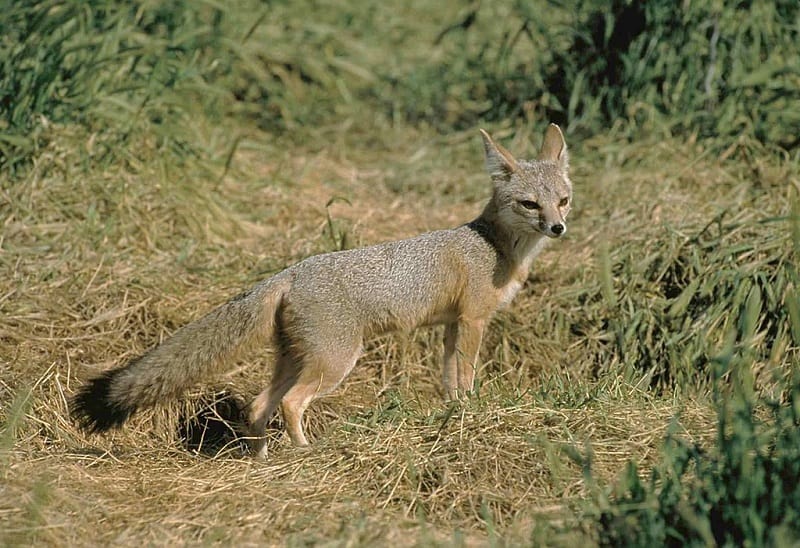
Kit Fox
What Do Kit Foxes Look Like?
The Kit Fox has a different body style than other foxes with a slenderer body. A full-grown fox stands about 1 foot tall and weighs no more than 4 lbs. It has large ears, in relation to their body size” between 2 1/2 and 3 1/2 inches”.
The large ears provide a route for excess heat to leave the body and contribute to their exceptional hearing. They also have a long bushy, gray tail with a black tip. The color and texture of their fur vary with geographical areas. Most often, the main part of the body color is grizzled or yellowish-gray. Black-tipped guard hairs give them a grizzled appearance. The guard hairs are less than 50 mm long and prominent in the middle of the back.
They have stiff tufts of hair that protect the soles of their feet. The tufts of hair improve traction on loose sandy surfaces as well as protect against extreme temperatures. Their muzzles and whiskers are generally blackish brown.
Where Do Kit Foxes Live?
Kit foxes live in arid to semi-arid desert and grassland environments. They favor areas of sparse ground cover.
You will find them in Oregon, southwestern Colorado, Nevada, Utah, southeastern California, Arizona, New Mexico, and western Texas.
What Do Kit Foxes Eat?
The Kit Fox is a mostly carnivorous omnivore. They eat mostly meat. Occasionally they eat fruits and berries. The cactus fruit is one of their favorites.
They mostly hunt rodents but branch out to a wide variety of prey. Some of the animals they hunt include prairie dogs, rats, mice, rabbits, birds, lizards, snakes, and insects.
How Do Kit Foxes Survive in the Desert?
The Kit Fox lives a nocturnal lifestyle, which helps him stay cooler. During the day, they live in underground burrows and stay out of the sun.
Their large ears help dissipate the heat, while their furry paw pads help protect their feet while walking in the hot sand.
To keep them hydrated, their urine is concentrated to minimize water loss.
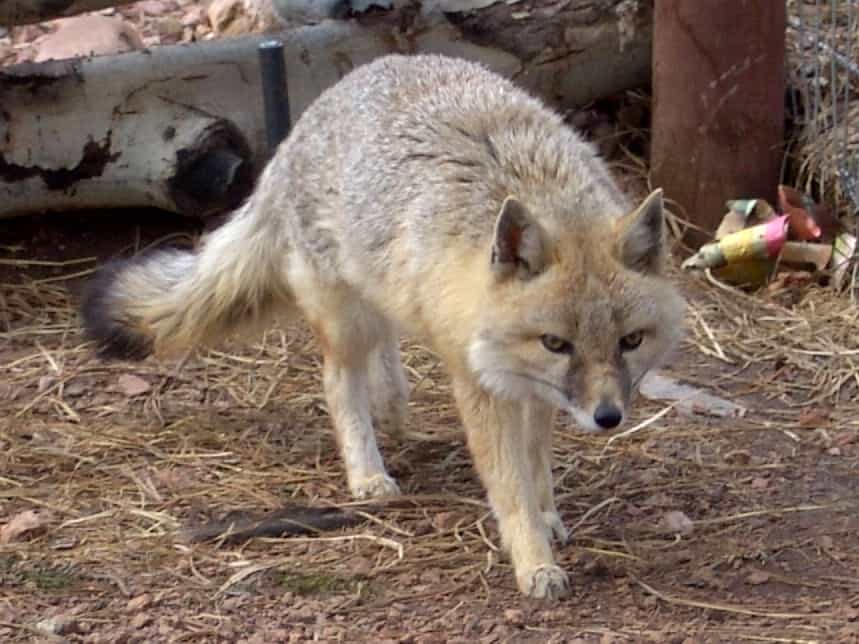
Swift Fox
Where Do Swift Foxes Live?
The Swift Fox is found in the western grasslands of North America, which encompasses Montana, Colorado, New Mexico, Kansas, Texas, and Oklahoma. It is also found in southern Manitoba, Saskatchewan, and Alberta in Canada.
What Do Swift Foxes Look Like?
The Swift Fox is approximately 1 foot in height and measuring from its head to the tip of its tail around 31 inches long, about a domestic cat’s size. It weighs anywhere from 5 to 7 pounds. Males are slightly larger, although males and females look similar.
They have dark, grayish, tan fur over their bodies with yellowish-tan fur across their legs and sides. The throat, chest, and belly vary from white to a pale yellow color. They also have black patches on their muzzle and black at the tip of their tail.
What Do Swift Foxes Eat?
Like most other foxes, the swift fox is a carnivorous omnivore. They hunt for mice, squirrels, rabbits, birds, lizards, and insects. They will also eat grasses and fruits during the summer months. The adults eat a large number of insects while feeding their young with larger prey animals. They will also scavenge on what other predators have killed.
How Do Swift Foxes Hunt?
As their name states, they are swift and agile, which helps capture their prey and escape predators.
Are Swift Foxes Fast?
They have been clocked in at speeds of over 50 km/h (30 mph) or up to 60 km/h (40 mph). They are fast but not as fast as the Gray Fox.
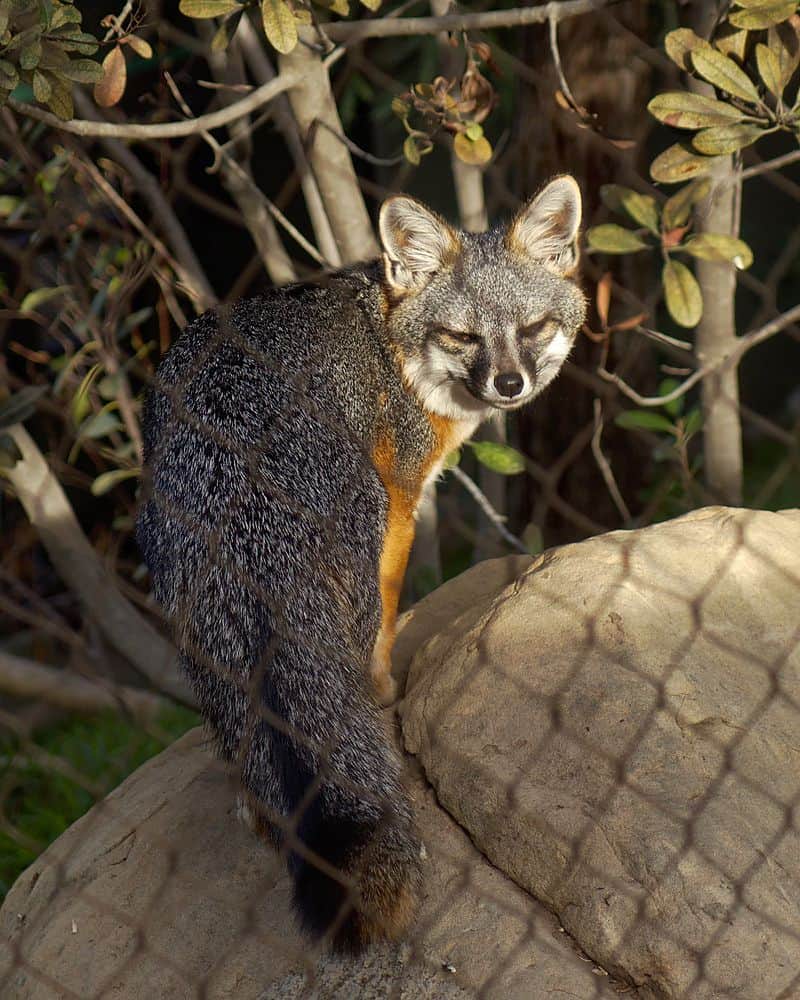
Island Fox
Where Do Island Foxes Live?
The Island Fox (Urocyon littoralis) is found on six of the eight Channel Islands of California.
- San Miguel Island
- Santa Rosa Island
- Santa Cruz Island
- San Nicolas Island
- Santa Catalina Island
- San Clemente Island
How Many Subspecies of Island Fox are There?
There are six subspecies of Island Fox, each unique to the island on which it lives, reflecting the foxes’ evolutionary history.
The subspecies are:
- Urocyon littoralis littoralis of San Miguel Island
- Urocyon littoralis santarosae of Santa Rosa Island
- Urocyon littoralis santacruzae of Santa Cruz Island
- Urocyon littoralis dickeyi of San Nicolas Island
- Urocyon littoralis catalinae of Santa Catalina Island
- Urocyon littoralis clementae of San Clemente Island
What Does Island Foxes Look Like?
The Island Fox is the smallest of the North American foxes. Measuring from his head to the tip of his tail ranges from 23.5 – 31 inches and measures 4.5–6 inches in shoulder height. He ranges from 2 and 6 pounds. The largest subspecies are found on Santa Catalina Island, and the smallest are found on Santa Cruz Island.
This fox has gray fur on its head, a copperish orange coloring on its sides. It has white fur on the lower half of its face, throat, and belly, with a black stripe on its tail’s dorsal surface. Between August and November, the Island Fox molts, but the pups generally have a darker coat than the adults before the first molt. A brown phase may occur in the San Clemente Island and San Nicolas Island populations, with the grey and black fur of the body replaced by a sandy brown and a deeper brown,
It is not clear if this is a true color phase, a change that occurs with age, or a possibility that a change occurs because of interactions with Opuntia cactus spines that become embedded in their fur.
What Do Island Foxes Eat?
The island fox eats fruits, insects, birds, eggs, crabs, lizards, and deer mice. The fox tends to hunt by itself rather than in a pack. Although it is known for making its appearance during the day, the island fox is mainly nocturnal. The activity also alternates with each season. For example, it is more active during the day in the heat of summer than in winter coolness.
How Many Island Foxes are Left?
As of September 2012, there were:
- San Miguel Island– 520
- Santa Rosa Island– 874
- Santa Cruz Island– 1750
- San Nicolas Island– 263
- Santa Catalina Island -1500
- San Clemente Island -1230 source
Recent Posts
The only venomous snakes in Washington State are Northern Pacific Rattlesnakes. The Northern Pacific Rattlesnake (Crotalus oreganus oreganus) is a sub-species of the Western Rattlesnake. Anyone...
Skunks are not classified as true hibernators. But they go into a state of torpor when the weather gets cold. Skunks are light sleep hibernators, along with opossums, bears, and raccoons. ...

